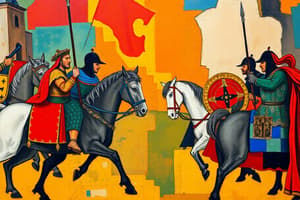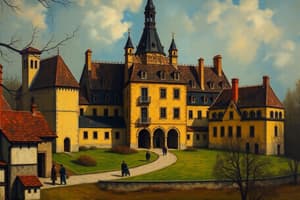Podcast
Questions and Answers
किस आधार पर यह कहा जा सकता है कि मध्यकालीन इतिहास अत्यधिक रोचक किस्म की कहानियों से भरा हुआ है?
किस आधार पर यह कहा जा सकता है कि मध्यकालीन इतिहास अत्यधिक रोचक किस्म की कहानियों से भरा हुआ है?
- प्राचीनता, और समुर्द्धि
- आर्थिक समर्थन, खेल, और समुदाय
- धर्म, संघर्ष, परिवर्तन, और विजय (correct)
- कला, और टेक्नोलॉजी
कौन-कौन से कला-सांस्कृतिक अभियानों का मध्यकालीन इतिहास में महत्वपूर्ण योगदान था?
कौन-कौन से कला-सांस्कृतिक अभियानों का मध्यकालीन इतिहास में महत्वपूर्ण योगदान था?
- प्राचीन संस्कृति की संरचना, महान कलाकृति की प्रेरणा
- महाकविताओं की रचना, सुंदर संग्रहालय
- पुस्तकों के सुंदर चित्रण, प्रसिद्ध प्राचीनिक निर्माणकला (correct)
- व्यापक वस्तुकला के संजीवनीत प्रतिष्ठान, महान संग्रहीत पुस्तकें
किस तकनीकी प्रगति के कारण में मध्यकाल में कृषि, पशु-पालन, और उत्पादन तकनीकों में ब्रेकथ्रू हुआ?
किस तकनीकी प्रगति के कारण में मध्यकाल में कृषि, पशु-पालन, और उत्पादन तकनीकों में ब्रेकथ्रू हुआ?
- मृदा में मिट्टी की पुन:प्राप्ति (correct)
- समुंद्री परिवहन के सुधार
- पेड-पौधों के समृद्धि
- होमस्टेडिंग के आरंभ
'सर्फ' किसे संलंबित होता है?
'सर्फ' किसे संलंबित होता है?
'Chanson de Roland' का क्या महत्व है?
'Chanson de Roland' का क्या महत्व है?
'Benedictines', 'Cistercians', 'Franciscans', 'Dominicans' को मिलकर किसे बल मिला?
'Benedictines', 'Cistercians', 'Franciscans', 'Dominicans' को मिलकर किसे बल मिला?
मध्यकालीन समाज की विशेषता क्या थी?
मध्यकालीन समाज की विशेषता क्या थी?
कौन-सी महत्वपूर्ण घटना के परिणामस्वरूप मध्यकालीन विश्व को सकारात्मक प्रभाव पहुंचे?
कौन-सी महत्वपूर्ण घटना के परिणामस्वरूप मध्यकालीन विश्व को सकारात्मक प्रभाव पहुंचे?
मध्यकालीन समय में, किसे समृद्धि के केंद्र के रूप में उत्थित होने का महत्वपूर्ण संकेत मिलता है?
मध्यकालीन समय में, किसे समृद्धि के केंद्र के रूप में उत्थित होने का महत्वपूर्ण संकेत मिलता है?
मध्यकालीन समय की महत्वपूर्ण समीक्षा में, कौन-कौन से प्रमुख संस्कृति-संबंधी परिवर्तन सहित होते हैं?
मध्यकालीन समय की महत्वपूर्ण समीक्षा में, कौन-कौन से प्रमुख संस्कृति-संबंधी परिवर्तन सहित होते हैं?
मध्यकालीन समय में, समुद्री-रोचकता के महत्वपूर्ण केंद्र कहाँ हुआ?
मध्यकालीन समय में, समुद्री-रोचकता के महत्वपूर्ण केंद्र कहाँ हुआ?
Flashcards are hidden until you start studying
Study Notes
Exploring Medieval History
The centuries spanning from the late fifth through the fifteenth century form what we now refer to as the Middle Ages, or more simply, medieval history. This period was marked by profound changes across Europe, encompassing political shifts, religious developments, technological advancements, and cultural transformations. Let's delve into some of these key aspects.
Political Landscape
Medieval society was characterized by complex feudal systems whereby landowning aristocracy granted lands in exchange for military service. Kings relied heavily upon nobles like counts, barons, and knights to maintain order and defend their realms against external threats. Meanwhile, powerful city-states emerged as centers of trade and commerce, exercising considerable influence within their territories and beyond.
A significant event in this era was the Crusades, which involved European Christians attempting to regain control of the Holy Land from Muslim forces. These conflicts had far-reaching consequences affecting religion, politics, economy, and identity throughout the medieval world.
Religion and Culture
Religious institutions such as the Catholic Church were central figures during the Middle Ages, wielding immense power and influence over daily life. Monasticism flourished with the establishment of various orders like Benedictines, Cistercians, Franciscans, Dominicans, and others, contributing to the reconstruction of communities following the decline of Roman civilizations.
Artistic endeavors blossomed, giving rise to Gothic architecture showcasing grand cathedrals, stained glass windows, magnificent sculptures, and illuminated manuscripts featuring elaborate illustrations. Literature saw the emergence of vernacular languages rather than Latin, leading to the creation of epics like Beowulf and Chanson de Roland. Additionally, chivalry became instrumental in shaping codes of honor among noblemen who embarked upon heroic quests and tournaments.
Economic Transformations
In contrast to prevailing agrarian societies, urbanization began to take hold, setting off new socioeconomic trends. Merchant guilds offered protection and support while promoting free trade, encouraging the growth of cities. Serfdom—a legal institution binding peasants to the land they worked for a manorial lord or an ecclesiastical superior—was prevalent, although there were instances of serfs gaining freedom via manumission, redemption, or other means.
Economy also witnessed breakthroughs in agriculture, animal husbandry, and manufacturing techniques due to technological progress. Agricultural practices gave birth to three-field crop rotation, making it possible to cultivate multiple crops annually instead of just one per year previously.
As you can see, medieval history is replete with intriguing tales of culture, conflict, transformation, and triumph. It serves not only as our window into the past but as a foundation upon which contemporary civilization continues to build. Understanding its nuances sheds light on how humanity evolved in response to challenges and opportunities alike.
Studying That Suits You
Use AI to generate personalized quizzes and flashcards to suit your learning preferences.




